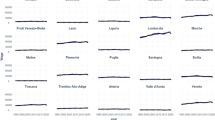Abstract
The main idea developed in this paper is that rising excess demand for the labour force results in higher growth of wages over the ‘notional’ rate of growth. The rationale is that employees change their jobs searching for higher wages, and employers are willing to offer higher pay in order to get additional workers. This relationship is highly nonlinear, and can be regarded as an extension of the idea known as the Phillips curve to the area of ‘negative’ rate of unemployment. Additionally, one can observe that if the disequilibrium intensity in the labour market is small, its changes cause stronger reactions of wages in strategic branches than in the remaining sectors of the economy. It is similar to the situation of excess demand for labour. If there is a high rate of unemployment, reductions of wages affect more branches of secondary importance for the economy. The empirical investigation is based on Polish data covering the time period from 1964 through 1984. As excess demand for labour is unobservable, a proxy is used as an indicator of disequilibrium. It is introduced to the equation explaining the rate of growth of average wages, in addition to the rate of productivity growth of labour and the rate of inflation. Estimates are derived for 10 industry branches and sectors of the economy. The results confirm the initial hypothesis.
Similar content being viewed by others
References
BarczakA., CiepielewskaB., JakubczykT., and PawłowskiZ. (1968), Model ekonometryczny gospodarki Polski Ludowej, Warszawa, PWE.
BowdenR.J. (1978), The Econometrics of Disequilibrium, Amsterdam, North Holland.
DębskiW. (1982), ‘Ekonometryczne modele płac i dochodów osobistych ludności w gospodarce narodowej’, Studia Prawno-Ekonomiczne, Vol. XXIX, pp. 91–113.
Dębski, (1987a), Ekonometryczne modele dochodów osobistych ludności Polski, Warszawa, PWE.
Dębski, W. (1987b), ‘Płace a ceny w skali makroekonomicznej’, Finanse, Nr. 9, 23–31.
Hansen, B. (1960), ‘Excess demand, unemployment, vacancies and wages’, Quarterly Journal of Economics, Nr. 1, 1–23.
KornaiJ. (1980), Economics of Shortage, Vol. A.B., Amsterdam, North Holland.
KrasińskiZ., MrukH., and SzulcH. (1985), Ceny a rynek, Warszawa, PWE.
Lipsey, R.G. (1960), ‘The relation between unemployment and the rate of change of money rates in the United Kingdom 1861–1975: A Further Analysis’, Economica, Nr. 1, 1–31.
MaciejewskiW. (1976), Zastosowania ekonometrycznych modeli rozwoju gospodarki narodowej, Warszawa, PWE.
MelichA. (1972), Technika płac i kierunki jej usprawnienia, Warszawa, PWE.
MelichA. (1987), Organizacja i technika płac w przedsiebiorstwie, Warszawa, PWE.
MoreckaZ. (1959), ‘Płaca w gospodarce socjalistycznej’, Zagadnienia ekonomii politycznej socjalizmu, O.Lange, K.Łaski, and J.Rutkowski, eds. Warszawa, KiW.
PhelpsE.H. (1970). ‘Money wage dynamics and labour market’, Microeconomic Foundations of Employment and Inflation Theory, E.H.Phelps, ed. New York, W.W. Norton.
Phillips, A.W. (1958), ‘The relation between unemployment and the rate of change of money wage rates in the United Kingdom 1861–1957, Economica, Nr. 4, 283–299.
Walfe, A. (1984), ‘A disequilibrium model of consumers' goods markets: model WA-1’, Netherlands Economic Institute — Foundations of Empirical Economic Research, Nr. 1/1985.
WelfeA. (1990), Rynek w warunkach inflacji. Studium ekonometryczne, Łódź, Wydawnictwo Uniwersytetu Łódzkiego.
Welfe, A. and Welfe, W. (1986), ‘Modele i prognozy rynku w warunkach nierównowagi, Ekonomista, Nr. 2, 279–314.
Welfe, W. (1973), ‘A medium-term econometric model of the Polish economy, Prace Instytutu Ekonometrii i Statystyki Uniwersytetu Łódzkiego, Nr. 8, Łódź.
WelfeW. (1981), ‘Modele ekonometryczne w procesie planowania gospodarki narodowej PRL, Metody i modele ekonomiczno-matematyczne w doskonaleniu zarządzania gospodarką socjalistyzną, W.Welfe ed., Warszawa, PWE.
WelfeW. (1982), ‘Modele gospodarki socjalistycznej’, L.R.Klein, ed. Wykłady z ekonometrii, Warszawa, PWE.
Welfe, W. (1985), ‘Econometric macromodels of unbalanced growth’, Prace Instytutu Ekonometrii i Statystyki Uniwersytetu Łódzkiego, Nr. 52, Łódź.
Author information
Authors and Affiliations
Rights and permissions
About this article
Cite this article
Welfe, A. Modelling wages in centrally planned economies: The case of Poland. Economics of Planning 24, 47–58 (1991). https://doi.org/10.1007/BF00361114
Issue Date:
DOI: https://doi.org/10.1007/BF00361114




